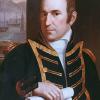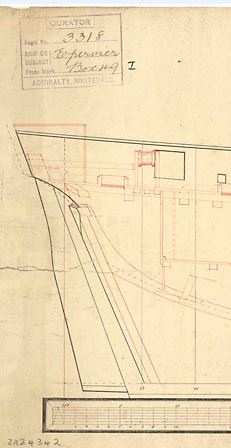-
Posts
178 -
Joined
-
Last visited
Content Type
Profiles
Forums
Gallery
Events
Posts posted by Chapman
-
-
-
Quote
We know, absolutely, that SR always had a forecastle. Are we to believe that Jean Berain “forgot” to include this detail? As many times as I have looked at this drawing, I have never noticed this discrepancy. But, there it is! I have no theories or explanations for that one.
Maybe this is an early version, as an alternative to make the SR a second rate?- Hubac's Historian, EJ_L and mtaylor
-
 3
3
-
Moin/Hello!
Interesting question for me, because I'm building the Bucentaure and Redoutable. and I had not thought about it yetQuoteThe surface of the hatch is lined with tin-plate underneath, and this lining extend up into the smoke scuttles, which have removable hoods or cowls in iron-sheet
Ringbolts fastened in each corner of the hatch allow it
to be removed and thrown it into the sea if,...Source: The Seventy-Four Gun Ship Vol. II
The above installation was probably built for some time longer. In 1787 a new furnace was tested on the Leopard, a ship of the line. As a result, it came from about 1800 to changes. One was a version with two fume-pipes ( contemporary Friedland model, another with a folding grating (contemporary model Flore), and later with one fume-pipe including watercooling (contemporary model Duquesne)
-
On 2/3/2019 at 7:56 AM, mtaylor said:
Interesting bit here (as are the rest of what you're thinking and finding). One thing that struck me was that considering the era, I'm wondering if the forecastle was too high (to limit visibility from the poop deck by the officers? Or perhaps it was a balance problem and the bow was too low in the water? Just musing out loud as it were.
Rickenbacher writes in his notes that by weight reduction, by removing the back, the maneuverability should be increased.I guess, the Monarque, was probably during the Candia Mission with the bow too deep in the water. That would have had an influence on maneuverability.The ship is difficult to tack through the wind and dives deeper into the sea/waves.Edit:Maybe the back deck was not completely removed, and only the cannons and the bulwark were removed?After dismantling the back, the Ship had instead of the 94, now only 84 guns.
-
Quote
Hello, Chapman! That is awesome news about La Reine. Are you doing a complete scratch-build, and will there be a build-log for the project?
I believe that the Heller kit of Phenix after extension, widening and a new bow and bulwarks, built as a waterline model, could correspond to the appearance of the v.d.Velde illustrations. That's what I want to prove, and then it's decided if the model has a future- mtaylor, Hubac's Historian and EJ_L
-
 3
3
-
Very interesting! I did not dare to translate from the French sources. I'm looking forward to the next part.Sorry that I have not written anything for so long. There was a lot of work in our home. To the question asked some time ago, if I want to build the Reine. Yes, I started a waterline hull of this ship.- Hubac's Historian, EJ_L and mtaylor
-
 3
3
-
Hello from Germany, first of all, I've been little concerned with the Royal Louis. The book I linked and read in parts "About the waves ..." I have acquired as background knowledge for the decoration of Hubacs Reine. In my humble knowledge, Grand Monarque and Royal Louis are one and the same ship! There was also a Monarque but that was a two- or three-decker with two covered gundecks. This Monarque sailed on its first mission with a part of the ornament of Royal Louis because its own decoration was not yet completely made. The lower anonymous drawings shown above are from a report about Royal Louis published by Commissaire Hayet in 1677 and show the ship after a first conversion. The ENSBA total rear view of the ship is, according to Charles Le Brun, a design drawing of the Royal Louis from 1668. On the transom stands P.P.F. 1681 and on the back Pujez, 1668 (?).How all this fits together? At the moment, I do not know. I think the book is worth it because of the research and because the author explains the symbolism of the figures and different coat of arms of the leading families.At this point, I would like to thank you for this inspiring research and building report, Fantastic work!
Joerg
- shipmodel, Hubac's Historian, EJ_L and 1 other
-
 4
4
-
Hello, this book Über den Wellen bin ich einzigartig: Das Skulpturenprogramm am Heck der Royal Louis (1668) deals extensively with the decoration of the Royal Louis. It is, however in German, maybe anyway interesting? -
Congratulation on winnig this important point !
I can empathize with your feelings.

- mtaylor, EJ_L and Hubac's Historian
-
 3
3
-
Mr. Frolick, Sir!
I love your sense of humor.

- mtaylor, CaptainSteve, uss frolick and 1 other
-
 4
4
-
http://www.modelsailingships.com/text/grass_text.html
Hey guys according to this link the ships of 1811/1812 did not have a square tuck stern. So the first Grasshopper probably had one while the second did not. Also says the Epervier did not. Assuming we can trust this one source but that's my opinion that the tuck was probably something removed after 1810 but still not considered obsolete circa 1804. There is a 4/5 year gap in builds for the Cruizer class after 1807 so probability a chance for the plans to be revised a bit.
Moin from Germany.
Sorry, but the plans of the Epervier say something differentSquare Tuck!Source: NMM- uss frolick, mtaylor, jwvolz and 2 others
-
 5
5
-
Does anyone have a set of rigging plans I could purchase? I am building the Julia which is a brig sloop of the seagull class which appears very similar to the cruiser class and when I purchased the plans from the admiralty they did not come with rigging plans.
Hello !Perhaps also of interestThere are also plans of the Seagull in the Danish archives. Including a plan of masts with dimensions. However, the figures are for the second half of 1808. So I'm not sure if the Danish standard shows. -
-
Hi Bava,
Hilhouse built the Termagent speculatively on the new Hilhouse shipyard at Redclift, after he built the Privateer Ship Mars ( 1779 cooper sheathed) Both were based on the plans of Ceres 1777.
Hilhouse knew the good sailing qualities of the Ceres from his former work at the Royal Shipyards in Chatham and Woolwich.
From Mars, there is a print of Pocock and a shipyard model of her held by the Bristol Museums, Galeries & Archives -
That's fantastic, thank you for this document.
- thibaultron and Marcus.K.
-
 2
2
-
Hello ,
Thanks for the posts regarding the Privateer Marines .
I find it interesting that so far no one on the possibly only book on the subject has reference ... The book I've found recently , but unfortunately not purchased because of the price .So unfortunately I can not contribute anything substantial on the subject
MARINES OF THE Privateers - WAR OF 1812
McClellan , Edwin N. - Major , U.S. Marine Corps , Officer in Charge, Historical SectionPs: Frolick thanx ! I will look for The Republic's Private Navy: The American Privateering Business as Practiced in Baltimore During the War of 1812
-
Hello ,
an interesting discussion. I have a question and think here is the right place to ask.
On the Muster Roll of the Prince de Neufchatel Marines are listed..http://www.1812privateers.org/Privateers/crew.html
Were the members of the U.S. Marine Corps or special privately funded Privateer Marines ? -
Hi!
After Irving King The Coast Guard under Sail 1989
80 tonner:
Surprise in 1815
Dallas 1821
Crawford 1821
all built in New York
51 tonner:
Louisiana 1819
Alabama 1819
all built in New York
and probably
Search 1815 Newport, Rhode Island
Detector 1815 Newport, Rhode Island
Wasp in 1815 and a second Detector 1815 Portland, Maine
Without warranty, because of the quick look I threw in the book.
King, unlike Chapelle,.calls his sources. And these sources seem convincing to me.
An interesting book whose purchase is also worth due to small anecdotes from the life of the ships.
-
Thanks for the review Wayne
The book is one of my favorite books about ships of the early U.S. Navy.
And for a while I wanted to build models of the two ships.Sounds like a great book! I'll definitely be picking one up ...


- trippwj and uss frolick
-
 2
2




Soleil Royal by Hubac's Historian - Heller - An Extensive Modification and Partial Scratch-Build
in - Kit build logs for subjects built from 1501 - 1750
Posted
It was just a thought, have nowhere read what that supports. However, older ships were often reduced in superstructures and or armament and were downgraded. Such as the HMS Victory, she served for a time after Trafalgar as a 98 gun second rate. Incidentally, the Berain drawing discussed here is, apart from the frame, identical to that in blue color.The work on the Reine rests, I'm still busy with two other french beautys.😇